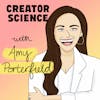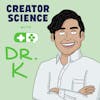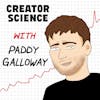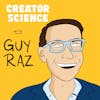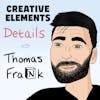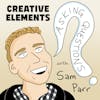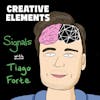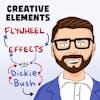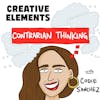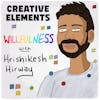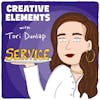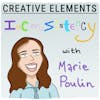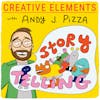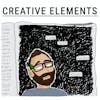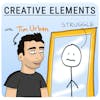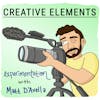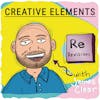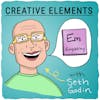
#3: Danielle Evans – The creator of food typography on earning a living, competition, and changing creative directions
Play EpisodeDanielle Evans is an art director and designer that uses real life objects to create pause in a fast paced, digital world.
Danielle Evans is an art director and designer that uses real life objects to create pause in a fast paced, digital world. She pioneered Food Typography in 2013 and has worked with the LA Times, Disney, Target, TheGuardian, McDonald's, (RED) campaign, Wix, Aria, Kellogg, Frito Lays, Cadillac, Tesco, and PwC just to name a few. In this episode, we talk about earning a living, competition, and changing creative directions.
Transcript and show notes can be found here
***
LISTENER SUPPORT
Join our community on Facebook
Support this show through Buy Me A Coffee.
***
SPONSORS
Try Podia and save 15% for life as a Creative Elements listener
Start your free trial of SavvyCal and get your first month free using promo code ELEMENTS
***
ABOUT JAY CLOUSE
Subscribe to my weekly newsletter
Enroll in my course on podcasting, Podcast Like The Pros
***
PODGLOMERATE NETWORK
This show is a part of the Podglomerate network, a company that produces, distributes, and monetizes podcasts. We encourage you to visit the website and sign up for our newsletter for more information about our shows, launches, and events. For more information on how The Podglomerate treats data, please see our Privacy Policy.
Since you're listening to Creative Elements, we'd like to suggest you also try other Podglomerate shows surrounding entrepreneurship, business, and careers like Rocketship.fm and Freelance to Founder.
Learn more about your ad choices. Visit megaphone.fm/adchoices
Danielle Evans 0:00
He was like, Oh my god, what is this? And are you ready to,C ould we talk tomorrow? I mean it's in a day, but we have like our copywriters going nuts with all these ideas. and I went, oh shit oh shit oh shit. Like, I think I'm on the edge of something!
Jay Clouse 0:15
Welcome to Creative Elements, a show where we talk to your favorite creators and learn what it takes to make a living from your art and creativity. I'm your host, Jay Clouse. Let's start the show. Hello, welcome back to Creative Elements. Thanks for tuning in. On July 11 2013, the Instagram Account Food Typography made its first post. It was a pretty low res photo and ex-pro, too, as many photos were back in 2013, of a man taking a photo of what looks like stylized yellow powder. The caption read "Almost Done," and the photo received no comments and still to this day only has 15 likes. The next day another photo was posted on the same account, but this time, it wasn't obscured by a photographer, and it had the words "Imported Peppery" done in lettering. But that lettering wasn't done in pencil or paint or digitally; ot was done in spices. This photo had a lot of comments, saying things like "beautiful" and "this is delicious work." That wasn't just the beginning of the Food Typography account, but it was the beginning of Food Typography as a whole, according to its creator, Danielle Evans. The account grew, the photos got better, and food typography became a thing. Danielle Evans is an art director and designer that uses real life objects to create pause in a fast paced digital world. Sh uses photograph, stop motion, and video to create delicious and visually stunning maps. images for billboards, commercials, installations and social media campaigns. She pioneered food typographic in 2013 and has worked with the LA Times, Disney, Target, The Guardian, McDonald's, Kellogg, Wicks, Cadillac, and PwC, just to name a few. Danielle was at the forefront of the food typolography and dimensional typographic trend, and it earned her the ability to work with some very big clients. In this episode, Danielle, and I talk about her journey as an artist, the ways authenticity and vulnerability have both helped and sometimes hurt her, the ways being first to do something isn't all it's cracked up to be, and what happens when you want to take a step back from the thing you worked so hard to create. By the way, at the time of this recording, I was just getting over a little bit of a bug. So I apologize for my voice. But don't worry, I'm healthy now. I'd love to hear your thoughts on this episode as you listen. You can find me on Twitter or Instagram @JayClouse, but now let's talk to Danielle.
Jay Clouse 3:00
So before you had this dubious distinction of creating food and dimensional typolography, what were you doing?
Danielle Evans 3:05
I was working at the mall. So I got a degree in illustration, which, I mean, for someone who's from like a blue collar, small town with a very humble like, family line, ;ike, that's pretty unheard of already. But then to throw in the time period in which I graduated, which was during the housing crisis, people were like, Okay, if you don't know anybody, and if you don't have the connections, good luck working at the mall. I was like, Oh, shit, and they're like, yeah, just till this blows over. Oh, when will that be?
Jay Clouse 3:36
Till this blow over...
Danielle Evans 3:36
Yes, when will we start being able to afford houses again?
Jay Clouse 3:39
Yeah.
Danielle Evans 3:41
So I spent a lot of time just being filled with malaise and depression and being like, why did I spend all of this money that I didn't have to go to school to learn a thing I can't use? And so from there, that's where I started, in my off hours and my evenings, figuring out ways to express myself in a resourceful manner. And I started learning that food and some objects are cheaper than art supplies, and they serve that dual purpose of being able to be scraped back into a bag and eaten later, on top of making something visually arresting. So that's really where this started for me. And it's nice because that level of resolve and I think just a very humble, borderline humiliating, beginning, it's a lot easier to relate to people whose stories aren't lining up perfectly.
Jay Clouse 4:27
Yeah, it strikes me that a lot of people were probably in that circumstance of, I spent all this money, and it isn't just related to illustration or art school.
Danielle Evans 4:35
Right.
Jay Clouse 4:35
You know, it's a lot of people saying I spent all this money to go down this path that I was told to go down when I was 18. And now either I can't do anything with it or the things I can do with it, I don't want to do with it.
Danielle Evans 4:45
Yeah. And I think to again, it's that idea of being open and flexible in your thinking, like I truly learned how to tell stories, whether that was through paint, which I was very, you know, bad at, or sculpting, which I turned out to be much better at as my job has shown me. I learned how to move a narrative and a story arc and how to engage with people and how to touch them through an emotional experience. And so I'm realizing, like, almost all of us have those threads that are passing through our story, but we don't know which ones are important until we pull on them.
Jay Clouse 5:16
So if I'm that person today who's sitting with this malaise of what am I going to do.
Danielle Evans 5:21
Right.
Jay Clouse 5:21
You know, how did you push yourself to continue to explore and try and say, I'm going to make my own path?
Danielle Evans 5:28
I think in a lot of ways, the market dictated that for me. Around the time I was deciding, oh, you know, what, I have been very attracted to lettering as a concept. And for those who are unaware, lettering is drawn typography. So if you're gonna use a pencil or a calligraphic pen or a paintbrush to make an alphabet of some sort, for people in my industry that ends up becoming logo types, that ends up becoming T-shirts or various things like that. And almost all of these things then can be key art and commercials. I mean, there's tons of applications. You've seen them all the time and you just don't understand that's what you're looking at. For me, I was like, oh, people who are making lettering, it's pixel perfect, it's extremely clean it's vector, which means it's that like graphic flat style that works well on, in digital spaces. I thought, Well, I'm not, I'm not those things. I am 85% done. And the last 15% is cobbling something together hoping that this is finished. I'm detail oriented, but not in a way that most people would understand. I can see a general picture and agree with it and then be like, oh, there's one or two things wrong with this. But it's only because the greater whole feels finished. And so that's when I started understanding like, I'm not where the market is, and the market is already really loud. How do I go somewhere slightly different. And so for me, I started my path on to things that I can touch, taste, feel. Multi sensory stuff is far more interesting to me. Let's start there and see what happens. And it turns out, the markets were getting really tired of people being pixel perfect. We wanted something that was friendly, and it happened right around the time that corporations were like, you know what, we want to come off as like people, we want to come off more as like warm, fuzzy entities that you just know, just your brand pal. So it was a great fit when I started launching,
Jay Clouse 7:17
I think I was scrolling back through the Food Typography Instagram today just to like, get a full history. And the first post was 2013 on that account.
Danielle Evans 7:26
Yes. Yes.
Jay Clouse 7:26
So for context, I know that me not being nearly as deep in the creative world as you are, started noticing lettering maybe in 2016, 2017.
Danielle Evans 7:36
Sure.
Jay Clouse 7:36
What was the state of lettering in 2013? Because it seems like it's gotten pretty hot, if you want to call it.
Danielle Evans 7:42
Yes, yes, it is. Well, that's funny, you would say that because I remember being in school around 2008, 2009. And that's around when I started finding it, realizing that I had a foot between illustration and design, and that's exactly where lettering lives. That was when I started coming across, I would say like, People in New York is what I want to say like New York friends, Jessica Hish, John Contino, Dana Tenamochi, Dan Cassarro, these people who really kind of reinvigorated this as a discipline and enlivened it in a digital age, like made it accessible in a digital age. That's when they were coming into, quote, their power. So I remember seeing these people and going, Oh, there's a, there's a space for this. But they we're like, 12 different people doing it really well. There can't be any more room for me. I remember getting into lettering really like pushing myself around 2011 to start exploring this discipline. And I remember my family members being like, what do you, what do you do? What is that thing that you do? And I'm like, explaining what lettering is. They're like, okay, okay. They still didn't understand. But by the time like 2015, 2016 hit, you're like, Oh my God, I've taken your lettering class. I mean, it was so cute. And I'm opening my own like card shop and this is gonna be so great. I'm like, really making all my own designs and all my friends weddings, like all of their announcements, you know, and I'm like, mmhmm.
Jay Clouse 9:01
Yeah.
Danielle Evans 9:01
Neat for you.
Jay Clouse 9:02
Yeah.
Danielle Evans 9:02
But understanding like, oh, now the public has a context...
Jay Clouse 9:05
Yeah.
Danielle Evans 9:05
...that they didn't have before.
Jay Clouse 9:06
So when you're posting these first photos in like X Pro 2 on Instagram, back in the glory days of Instagram, did people get it? Like, what did people think about this?
Danielle Evans 9:16
They had, people had a very distinctive reaction. And I like to think of it as like a sniff, a lick, and a bite. And I think this is applicable to the way most people in just, for lack of a better word, content. So someone would be scrolling and they'd sniff this thing, and they'd go, Wow, that's really interesting. And then just kind of keep going or they'd be like, oh, weird, this some food or something, I don't know. But then they would eventually get to the lick where someone would linger a little longer and they'd go, Oh, this is fascinating. This is made out of food. It says something it looks like someone did this on the computer, but it's real. And then there would be those few that would almost take a bite out of it where they would just really chew on the concept, and go, Oh, she used this kind of ingredient which is very fluffy and speaks to the, like, message that she's putting out there, everything feels very soft for the holidays, it says a "Marshmallow World" out of marshmallows, but it's about snow, and oh my god, that's so clever. And that was kind of when I realized that if you build in layers to the truth that you put in your creative work, people will ingest it on all different planes. So the idea is not to appeal to those who will only skim the surface; it's to get as deep as you possibly can and know that there will be people all along the way that will dive in at different levels.
Jay Clouse 10:30
So did you ever get any weird looks like a grocery store buying way too much of some type of thing?
Danielle Evans 10:35
Oh, it's really uncomfortable. Yeah, I can't tell you Like, just canisters of whipped cream. And people were like, What is she doing at her house? Or we, one of the very first things, one of the very first jobs that came through for me, there was a meat company, Belle Campo Meat, out in California, and they were like, Hey, would you do something for us for our quarterly? Could you make something out of raw meat? And I'm like, yeah, I'll just pick them up at the store. And they're like, Oh, no, no, no, we are going to send you our finest meat, we're going to send it this way it's going to be ground, whatever, tracking information. And then they forgot to give me the tracking information.
Jay Clouse 11:08
Oh no.
Danielle Evans 11:09
So I walk outside one day and there are 17 pounds of grade A beef in the middle of July waiting outside my apartment.
Jay Clouse 11:16
Oh, no.
Danielle Evans 11:17
Oh, God. And so I'm like, trying to like crack all this stuff open and like, How do I know if it's good? How do I know if it's good? They were like, break it open, if it's doping inside, it's good. I'm like, just freaking the fuck out. And my neighbors are like, What is she doing? And it's just the state of things now.
Jay Clouse 11:31
That's amazing.
Danielle Evans 11:32
I mean, when I was when I was in art school, I remember like, carving a baby out of a potato into a trash can. And don't ask me why. It was part of a 2d project. And I'm just like, oh natural objects.re And I'm like, I guess this is just me being an artist, now this is just my path as a creative. And I didn't realize how true that was.
Jay Clouse 11:52
Yeah.
Danielle Evans 11:52
So it's just been like being willing to do the weird odd thing, because you understand that some greater force either within you or outside of you is pulling you towards a path. And you just have to be obedient to that.
Jay Clouse 12:05
When we come back, we'll dive deeper into when Danielles business began to take off. When we left off, Danielle had just started noticing that people were becoming interested in this new strange art form of food typography. But it may not seem obvious at first that someone will pay you to play with your food. At what point did you think that people would actually pay you to do this?
Danielle Evans 12:28
I wasn't sure, to be honest. And it started in a strange way. I started realizing that I had been doing work that I thought people wanted from me, that they expected from me, which would again be like these pixel perfect things or trying to make wedding invitations or logos that I wasn't really feeling and wasn't charging enough money for because again, I didn't understand what I was doing. But it wasn't until I gave myself permission to enjoy the work and to be like, Look, what I'm putting out there is really weird, and it might not take and it might not be anything, but I will admit it's a hell of a lot more satisfying than being poor and miserable. So let's just be poor and happy. And as I start playing with this, and I'm finding a lot of joy in this process, it's very much play. It's just like, Oh, well, this was not actually so hard. And the creative process, which had been so laborious for me, became smooth. And so I put this out into the world. And people immediately were like, what is this? Because I mean, for years, people have been making things out of out of food and objects, but it was just kind of like a child playing with it. Nobody was exploring, adding this refinement of a designer's touch to these things. And so it was, it was reinvigorating and reinstitutionalizing this idea of, oh, there could be refinement in these utilitarian things that we handle every day. And so that's kind of been like a little sub tagline for me is like unlocking the magical and powerful metaphors contained in everyday items. And so from there hype just grew because people were like, I don't know what this isI', ve never seen this before, can you make more? And I'm like, Oh, I'm making more. And so I'm just cranking things out left and right. And it wasn't until I had four projects, just four in my portfolio that gave any indication of what I could do. And again, I still had all my traditional design and illustration work in there because it was afraid to let that go and didn't know how far this was going to go. But I remember seeing one of my friends, who was an art director at Target at the time, tweeting about work opportunities for lettering people. And so I was like, Hey, I know you've got hundreds of requests here, but if your game, I'm game, here's my stuff. And he was like, Oh my god, what is this, and are you ready to, can we talk tomorrow? I mean, it's any day but we have like our copywriters going nuts with all these ideas. And I went, Oh shit. Oh shit. Oh shit.
Jay Clouse 14:48
Yeah.
Danielle Evans 14:49
I think I'm on the edge of something. And the crazy thing was when I went to negotiate and then eventually do this job, I never considered that it was the most money I had ever made in my life doing anything. It was just that much fun. So from there, I did one job, went, Holy shit, I think I'm not going to be asked to do this again, but boy, that was cool. And the more people kept asking me to do it. So that's kind of where this started.
Jay Clouse 15:11
Yeah, I like to think of when people go off on their own and they start being their own boss or building their own thing. It's kind of like you have, it's like the Wright brothers in the airplane. And there's like pushing it and like trying to get off the ground and all sudden it kind of takes off.
Danielle Evans 15:25
Yeah.
Jay Clouse 15:25
So, was was this target client or that kind of project your takeoff moment for that airplane?
Danielle Evans 15:31
Sort of, yeah. And I mean, it was still bumpy. Like, at that time, I was doing, I did end up getting into some design work and I was helping out with branding over at Nationwide Insurance. So I was riding my little bike from my house in the rain or like running in the snow like down to Nationwide, doing my best and then coming right back by foot because at the time, like my family only had one car, so I did not have it. And I realized like while this was going on, I would have a strange, it would be this most surreal sensation of going into work, and seeing like a portfolio creative calendar I made just hanging in people's cubicles. And they had no idea that it was me. Not at all. I would have to go up to my boss and sheepishly be like, hey, can, can I try not come in next week? I'm really sorry. I know, this is short notice. And he's like, yeah, is everything okay? I'm like, I'm doing a commercial in New York, and I gotta go, when he's like, get out of here.
Jay Clouse 16:28
He's a good Boss. He's like, yeah, you should do that.
Danielle Evans 16:30
Yeah, exactly. And it's just so funny because like, I mean, you never think any of this is gonna work until it works. But if you've read Malcolm Gladwell's books and you've seen the whole case study on Warby Parker, they were very much the same way. They didn't know what they had, and they didn't know what it was going to become. And so a lot of times I think we are right on the edge of brilliance. And we just, either we haven't found the bravery to execute or we haven't found the right network or the right audience, but it's, it's there for us.
Jay Clouse 17:00
Yeah.
Danielle Evans 17:00
Like I have to think that these things these desires and dreams are put inside of us for a purpose and not because the universe or God or whatever you believe in is cruel. But I think it's because that's truly on us to execute, and we are the only ones that can do the thing...
Jay Clouse 17:14
Yeah.
Danielle Evans 17:14
...that is placed there.
Jay Clouse 17:16
So Danielle started to see that her food typographic was beginning to attract clients. But I wondered when she started to think that this may actually be able to support her. When did she start thinking that this may actually be a business? At what point did you think of yourself as a business owner?
Danielle Evans 17:32
Oh. Well, I, so I remember getting out of school and working at the mall and being an artist with a floppy hat. And I was so angry at business. For me the idea of business, we would joke and say like math is antithetical to art. But that's not true. Business is antithetical to art. And I started realizing that the way most people in my life experienced and created business was pulling the wool over someone's eyes, charging them too much for a thing that didn't work for them, and then running away before anyone can know the difference. And I thought I never, ever, ever want to be this. Can I even be a professional artist if I'm not willing to be this? And I realized, very few people do good business, but good business is offering something at an affordable price, a fair price, for someone who needs a thing. It solves the problem. And everybody walks away satisfied.
Jay Clouse 18:24
Right.
Danielle Evans 18:25
That's...
Jay Clouse 18:25
It's not winner and loser, it's winner and winner.
Danielle Evans 18:27
Right, exactly. So the zero sum game that people play is not a game that I'm interested in. And so I started thinking okay, then what? What does that look like for me? And so from there, it was looking at target markets, and is my audience, who is, my audience me, and not knowing for sure if that was true, and ideating what I thought. Like, who I thought would be my audience, it turned out to be very different because this was very special work, and I didn't know that at the time. Like, so coming into, it was for me making this transition of realizing like, I'm very methodical and strategic. As much as I am emotional and intuitive, I am also able to cobble these systems together, I'm dual brained. And so letting myself understand that there probably wasn't going to be a playbook for this necessarily, but I could pull from other people's experiences, and all of human experiences game, that's when this kind of changed for me.
Jay Clouse 19:20
Coming up, Danielle, and I talk more about putting ourselves into our work and the risks that come with it right after this. Welcome back to Creative Elements and my conversation with Danielle Evans. When we left Danielle, she was talking about her realization that running her own creative business didn't have a roadmap, and that she would have to create one herself. She told me that along the way, authenticity and vulnerability helped her to connect with our clients.
Danielle Evans 19:46
I'm very honest, and I'm honest to a fault with myself and with other people. And I think without having that level of comfort being authentic and vulnerable, you don't touch people. It's kind of like a movie with a protagonist that has like a bunch of different intersectional qualifiers, where you're like, Oh, I don't necessarily identify with the base level of this person because they have these other life components I don't understand. But then once the story progresses, you realize, Oh, this person has an experience that mirrors my experience, and I can relate to this. And so it's like, once you kind of plumb the depths of what makes us different--like the surface is where we kind of hang on to our differences--but when you scratch below that, we're all fundamentally the same. And I think that is a lot of what being willing to be authentic and vulnerable and honest can allow you to access, and that's what makes the work powerful.
Jay Clouse 20:40
Yeah.
Danielle Evans 20:40
And my work in general is very nostalgic. People see it and they're like, my childhood home, these memories I have playing sports, or I'm sharing a meal with my family. Like it's all part of a common experience. And I think in order to be able to access that, I'm pulling through people's past, I'm dredging up their emotions. It's very evocative. And you can't do that unless you're like, this was my experience, regardless of different team or table, it's probably close to you.
Jay Clouse 21:12
When we started this conversation, and I said, you know, how do you describe you? And you said, personal Danielle or business Danielle? And authenticity being so important to you, and the first time we talked, I was blown away by just how open and frank with me that you are. So how does authenticity play between this tension of, I have to be this person for my business to succeed versus I have to be this person for me to live with myself?
Danielle Evans 21:39
Right. That's a great question. And I feel like that's one that not all of us, almost none of us have answers to. For a long time, I always saw these, these two people, and this tension is like, well, I can eliminate the tension by just integrating. So I don't really have containers for myself. But then I started realizing, especially as you have things that go on in your personal life, if you're not somewhat compartmentalized, it bleeds through. And there will always be a measure of that. Like I went through a near death experience last year, I got divorced three years ago, I've had work trauma that came up this past year. And when you have these kind of really heavy things, weighing on yourself as a person who works for yourself, and also as a creative, the world is demanding that you bare your soul. And there are points where I've been like, I cannot bear my soul anymore, because I'm going to break. And so it's figuring out what parts of me can I give to my work and to other people that don't hurt? Things that I just have wellsprings of that are constantly overflowing, and in a lot of ways, teaching and sharing my inner thoughts, it tends to be very motivating or inspirational--I hate that word now--or just effective for people. And so in that way, I feel like I can be very comfortable with, this happened to me, this is what I learned. This is how I'm applying this principle to my life. And I can live with that.
Jay Clouse 22:59
Yeah.
Danielle Evans 23:00
But when it comes to, I want to put my face on social media, I'm going to be online all the time, I'm going to be telling you about these things that are up for purchase, but also like through the lens of looking vulnerable and authentic about having a slow week. Like, that's not authentic to me. And I feel like putting myself out there as any kind of like celebrity or, or search, or in search of status is not the kind of person I want to be. So I'm playing with this idea of being a little bit more private, in my public professional forum while still being who I am.
Jay Clouse 23:33
Yea, yeah, I've struggled with this too, because, you know, all of us run personal media companies right now.
Danielle Evans 23:39
Right.
Jay Clouse 23:40
Right. And so, well, honesty is kind of like a binary--you're either honest or dishonest in a situation--I feel like transparency is more of a spectrum.
Danielle Evans 23:49
Yes, it is.
Jay Clouse 23:50
It's about boundaries.
Danielle Evans 23:51
Yes.
Jay Clouse 23:51
It's about, I'll show you what is true and what is here up a point where I feel like I can't protect myself if I continue to share this with you.
Danielle Evans 23:58
Correct.
Jay Clouse 23:59
And I feel like that it is really important if you are showcasing your work for the purpose of professional clients seeing that...
Danielle Evans 24:06
Right.
Jay Clouse 24:06
...and hiring you. If you are sharing a lot and you don't put up appropriate boundaries,
Danielle Evans 24:11
Right.
Jay Clouse 24:11
That might lead to some uncomfortable either situations communicating directly with them or projects that they might want you to do...
Danielle Evans 24:18
Yes.
Jay Clouse 24:19
...that you don't feel comfortable putting under their name. You wrote a great piece recently about, can you work with big brands without losing your soul?
Danielle Evans 24:25
Yeah.
Jay Clouse 24:26
And I think that plays into this authenticity question, because I feel like a lot of people kind of face that struggle with themselves.
Danielle Evans 24:33
Yes.
Jay Clouse 24:33
Like, Can I see myself working with the big brand, you know, targets example of a big brand. But if somebody for whatever reason had a problem with Target or Chick Fil A or whoever it is, you know, how do you recommend they reconcile that tension within themselves?
Danielle Evans 24:48
Well, I try to see it as like a difference between a message and a value. Your value is internalized, it's something that you decide, and nobody else can impede upon that without your permission, whereas a message is something that we all share. And sometimes the people that present the same message have very different values. And so it's trying to figure out how to align yourself in a way where you're like, for example, I did some work with Walmart this year, which I was really loath to discuss, but the people were great that I worked with. And they were like, We want you to do something for Earth Day. Do something environmental. And I'm like, okay. But okay.
Jay Clouse 25:23
Yeah.
Danielle Evans 25:23
You know? And so I bought a bunch of plants. We made something up, like every day is Earth Day. And of course, when they posted this thing, there are just hundreds and hundreds of comments, like, You use plastic, you guys can rot in hell, you're destroying our oceans. Like you're a horrible company, the government, you're in bed with the government. I mean, just everything. So it was, I was like, the people that actually work here or buy from them or whatever are very aware of what their actual values are. But when it comes to the message, I have no problem aligning with them here because I do believe in recycling. I do those things. I am careful about my carbon footprint and my consumption. So in that regard, I'm like, I'll align with you for this. But value wise, that won't be a long term decision. And I, I've had people read that article and get a hold of me and go, you know, what I am a vegan, and I, one of my biggest clients is a leather producer, and I've had to work through the fact that I love beautiful products. I'm not about like, mistreatment of animals, and they're like this, this really helped me to kind of work through the tension of that, because I want to also live.
Jay Clouse 26:28
Yeah.
Danielle Evans 26:29
And so I recognize like, this is not clear. The way that we function in a capitalist society is not always clear. But it's upon us to be kind to ourselves and other people and determine what clarity looks like.
Jay Clouse 26:40
Totally. There's, there's so much nuance when you're working with a company that is that large that has these entrenched values...
Danielle Evans 26:48
Right.
Jay Clouse 26:48
...as a company. And if you're an individual, you know, you as an artist are working with a handful of individuals within that company, who may be trying to inspire change from within.
Danielle Evans 26:57
Yeah, exactly.
Jay Clouse 26:58
And who may be great people who share the same vision values and message that you do, but they're in this larger thing. So it's a question of, you know, do you take a stand against this big thing? Just to kind of show that you did, or do you say, here's the nuance that I see and how I can really align myself with this...
Danielle Evans 27:16
Right.
Jay Clouse 27:17
And also now give myself, you know, the practical funding to continue to survive, do the work that I love and make...
Danielle Evans 27:25
Right.
Jay Clouse 27:25
...change in my own way?
Danielle Evans 27:26
Yes, well, I've written about this also, the idea of abundance in a scarcity system, and understanding that we put all these limitations on ourselves working with the man or working as, like, a person who believes there's something out there for them and enough for everyone, yet, understanding that design and advertising and marketing are all scarcity based systems. So if you're going to be in those spaces, there are limited budgets, deadlines, campaigns, money, essentially. And so it's this question of like, how do you frame yourself in such a way where you can function from a space of, I'm going into this without fear, I'm going into this knowing that I have something to offer. And I can offer a lot of people similar things. And that's, that's been an interesting point of discussion for people in my industry, because they're like, God, I haven't really thought about this. And for me, it's this idea of, as I grow as a business person, and as I grow as a person, I'm leaning into the fact that I'm very complex, and I'm very emotionally complex and deep. And that depth allows me to parse through this nuance in a way that I can engage with it while being removed enough to have an analytical discussion about it.
Jay Clouse 28:33
Yeah.
Danielle Evans 28:34
And I think in our society right now, we're afraid of these nuances because everyone's afraid of being wrong and afraid of cancel culture. So we're going to just blanket good vibes only in the way that we present our businesses, but that's not effective because we're adults, and adults are to carry simultaneously conflicting things.
Jay Clouse 28:52
Yeah.
Danielle Evans 28:52
That's the point.
Jay Clouse 28:54
To this point, we've heard from Danielle how her new form of lettering, food typography, started to take hold. And big brands wanted in on it. But as with any good idea, competitors will pop up. And when competitors pop up, sometimes you want to stop competing. So you created food typography, dimensional typography. And now, almost seven years later, I'm sure there are a lot of people doing a similar thing.
Danielle Evans 29:20
Yeah.
Jay Clouse 29:21
So how do you think about yourself as an artist, as a business owner, having spearheaded this movement that is now more of a movement, they're more players there? Do you continue to kind of bask in the knowledge and the opportunity that comes from being the first and being kind of the trendsetter? Or does more noise in the space that you created pamper your own opportunity?
Danielle Evans 29:44
The latter, for sure. I think we tend to glamorize people who do something first. And in reality, we very rarely remember the first because the first is usually where they're working out the bugs and the kinks of things. And so it's the slicker second or third generation of whatever that comes around that we identify with strongly and remember and has some sort of longevity. And that really sucks, because if you're a foreigner of any sort, you realize every step takes twice as much and three times as much effort because it's not been done before. Nobody's been there in this space where you are. And so that, that is exhausting. And for me, also, I find I work best when I am presented with limitless possibilities. If I feel like I have all kinds of room to explore, that's where I shine, and realizing that there are people now where either I have to protect part of my process from them because they'll use it against me to get clients, or if I overshare like, hey, by the way, like it's been a slow however long, like I'm looking for work, and people go, Oh, this is not relevant anymore. You know, like, that's not the case. And it's now a matter of how do I handle and protect my path moving forward while at the same time being open to the fact that people will come behind me that will expand this as well as take from me? Like it's been this really fascinating look at...I've never had children, but I assume this is like birthing a child because the second it's out, it tries to get away from you. It's been fascinating because I think, Okay, well then if I've proven that this, this way of working, this novel way of working that has a very low overhead and extremely effective delivery, how do I keep this interesting for myself to grow and evolve? And how do I maintain a level of refinement and sophistication that people are not willing to touch? And so it's been this balancing act for me of like, figuring out how to raise my production quality, because people will look at that before anything else, even if the idea is better, but not done as well, realizing that my ideas are king and that that will always be the secret sauce of my work and making sure not to overshare those. Like, being seven years in has been fascinating because I'm at this point where I'm like, Okay, if I were to burn all of this to the ground and start over again, how would I do this differently? And not to say that I would give up what I'm doing and become a painter or a pottery person or whatever, because in the creative arts, people always think a pivot means you're just going to completely issue everything you've done. And that's bullshit. Who does that? Like, you're not going to throw away your business for anything. But realizing, like, how do I make it more palatable to myself? And how do I make it more palatable to other people? And that's the grind I'm in right now.
Jay Clouse 32:25
Yeah.
Danielle Evans 32:25
It's great. It's exciting. It's terrifying. But mostly, it's exciting.
Jay Clouse 32:29
Yeah. How do you how do you think about that tension? Or practically, hpw does it play out if you have this working business that has supported you for years, and now you're saying I might want to go zero to one again...
Danielle Evans 32:42
Yep.
Jay Clouse 32:42
...somewhere else. How long do you hold on to this thing that has existed to this point and still put some attention and some energy and some resources there versus looking ahead and saying this new thing, which isn't a complete pivot, but is different, it takes a lot of creative energy to think through. How long do you hold both, and to what degree? I know, there's no perfect answer here, obviously. I'm just curious how you've been thinking about it?
Danielle Evans 33:07
You're also a great interviewer. I just want to put that out there. Thank you for really brilliant questions. Well, I've, I've had the, I can say now, great fortune of having a lot of, like I've said rocky and traumatic things that have gotten in the way of my natural inertia. And so I've had to very thoughtfully consider what this means for me. And a lot of it has been about letting go. Like, at what point does one let go? Is it when the thing is on fire? Is it when it's sinking? Is it when you smell smoke? Like what, when do you acknowledge it's not serving you in the way that you want it to? And for me, it's been about realizing, well, what does my future look like doing this? And I'm struggling to see it. Or realizing like some of the work trauma I've experienced has been a deep disappointment with my peers and having people show me who they really are. And realizing, like do I want to service these people anymore? Do I want validation from these people anymore? Probably not. So fully recognizing there are seven and a half billion people on the planet.
Jay Clouse 34:08
Lot of people.
Danielle Evans 34:09
Yeah. There are enough people that if I want to put my efforts and energy anywhere else, I can. I can. And so just being comfortable and confident enough in, all right, what kind of a pivot is this? Is this a 6% pivot? Is this a 60% pivot? What does that end up looking like? Is it the way that I speak about myself that will need to change? Do I need brand assets that work a little differently? How do I move, and then further, how do I invigorate these things that I don't enjoy anymore? Like if you asked me, I don't enjoy Instagram. My audience has barely moved in two years. And frankly, I don't know if I want that audience anymore. I don't know if it matters to me, despite having modestly impressive numbers, like it's just not a, not a fascination. So I'm like, can I run a business where I'm not on Instagram anymore, just on it for funsies, like, I don't know, we're gonna find out. And so a lot of it has just been looking practically at, okay, what is working right now? What is not working right now? Are the people around me, have they worked for or against me in the way that they've done their business? Like, is that a purposeful thing or not, doesn't really matter? Like, you know, how, how is my audience been affected by algorithmic change? And starting to like work through the system of like, what is a better use of my time and a broader application of my time, and then coming to a place of like, Oh, I think different platforms will be better for this output based on the knowledge I have and the data that exists. Different language can put me in front of people, like I'm kind of ancillary working with the tech community. I think I want to be more involved in the tech community, like working with them. I work in very obvious food, like, industry stuff, but what if we got into more conceptual food industry stuff? Like what if my market changed geographically? I think I would probably be more successful in Europe. What does it look like doing that? So figuring out these components, and then I guess when you've raised a business, you understand that you kind of have a formulaic approach to this. But because you've done your first one, you don't always know what is formulaic about it. So now that I'm in the second phase of how do I turn this over, give myself a refresh, I see these building blocks and steps, and I'm being reminded of where I was sitting working through a business plan seven years ago, or who I spoke with, in this conversation that connected that I needed to think about my marketing in a certain way. And it's, it's almost like you're channeling yourself from the past, you know, go like, Oh, this is just gonna be part of every approach I ever take to do something new.
Jay Clouse 36:42
Yeah. And also, you know, once you've, once you've walked the path, for one business, you can look back at that path and see all the footsteps you take, and maybe, you know, the five or so that mattered.
Danielle Evans 36:53
I call that the breadcrumb trail. I mean, it makes sense with my work, but just being like I'm throwing shit at the wall all the time. I won't know what matters until I gaze back at it in retrospect, and only then will I be able to see what parts of it were important.
Jay Clouse 37:04
Well, something else that you said kind of offhand was when you spoke with your friend who was an art director at Target, what struck me about that was, one, awareness that you had someone in the right position or close to the right position at a corporation who could hire you.
Danielle Evans 37:19
Right.
Jay Clouse 37:21
And now juxtaposing that with thinking about your Instagram assets, you know, is my audience serving me? Well, the art director of Target is one of 19,000 followers on your Instagram. So how important is it to think of your social media assets and the following as being your customers or your clients versus saying, you know what, I know someone who's in the right position that can hire me. Are they thinking about the social proof of your Instagram when they hire you in the first place? You know, how, what's the interplay between your following versus your clients?
Danielle Evans 37:53
Interesting. Well, the thing that I have been telling people for years, because I know it to be true for me, and it, I think, it is universally true, is that analytics like that don't matter. They do not matter. Some of the most brilliant people I know have 3,000 followers on Instagram because they don't have time, and they don't care. And their markets are elsewhere. And that's fine. I know people who, like I have several friends on Instagram who are in the 60 to 70,000 follower range. And yet they're just they're doing everything right. They're doing lives. They're doing stories, they're cranking out work on a daily or bi-daily basis. And yet they're still like, I'm, I have gaps in my schedule. Like I have gaps. Does anyone know of anything? Could you please share my work? The algorithm is killing it. And I'm just like, the creative people now are being used to build social pyramids and validate these digital neighborhoods for gentrifying people, like...
Jay Clouse 38:52
Whoa...
Danielle Evans 38:52
Yeah, I've been writing about to, like big brands, celebrities, and your parents and... boomers. I'll just say it. But realizing that like, we have been brought in and we were enticed in at this like one to one distribution rate where it's like, oh, you put a thing out there, and the amount of people to follow, you will see it at the time you place it. One to one, gain a following. And that's where like the bulk of my followers were established, was through just doing this on a regular basis, realizing what time windows were best for different people based in different spots and going for it. But I realized now with the way that we're putting restrictions on things, we're applying social inflation. And so the social inflation is affecting who sees what when, how much we can deviate from the norm that we've established, which is not much what people. like what tags you're using, will these tags even be seen, will you get shown on the search page? Like how will this play out? And so we're at a point where we are being squeezed to produce more at a faster rate that might not even be as good just in the hopes that people get their eyeballs on our stuff. And I'm like, I don't want to be part of that system in that way. And so as I've tried to use the system in ways that still deviate from what I started as, I'm still not getting somewhere with it, and it's just me realizing I would have to spend an obscene amount of time on this platform, I would have to constantly be monitoring people on it, I would have to be begging everybody around me to share things. And while that is a part of business, I've not had the bandwidth for that, trying to get my own personal life in a place that I feel is like super healthy and fit.
Jay Clouse 40:28
Yeah.
Danielle Evans 40:28
So why would I, why would I continue to try to put energy there if it's not giving me return? Like any normal business person would be like, this is not worth the effort it's asking me, but it seems to.
Jay Clouse 40:40
Those platforms are just competing with themselves now.
Danielle Evans 40:43
Correct.
Jay Clouse 40:43
You know, and the weird thing is Facebook competes with its own property.
Danielle Evans 40:46
right, which I don't understand. Like, everybody saw the the beauty of Facebook and how it took off. And then everyone wanted to be Facebook. Twitter, Instagram until it was bought, like Flickr. All of these places wanted to be this spot. And instead of just cultivating their own culture or really working to their own demographic, they're like, Well, how do we, how do we like, share, and how do we comment? And how do we infuse various components? Like, how do we make more ads? And I feel like now as you're saying these places function almost like their own countries, so whereas you could have had like some sort of like, EU passport to get you from Twitter over to Instagram because of the way that they embedded links, you know are like Brexited and from...
Jay Clouse 41:28
Yep.
Danielle Evans 41:28
...making that transition smoothly, because they want to keep your attention. And I would argue that it's because the social currency of right now, of 2019, almost 20, is not, it's not your attention as much as it is your live time. That is where people are wanting you to spend your energy, is live on a platform/ And you are given more face time and eyeballs and whatever, whatever they're trying to generate in this false economy, provided that you are willing to be in any one of these places at once.
Jay Clouse 41:57
And meanwhile, your clients are coming from real people, real relationships that you maybe had for years. You know, I've had a couple of clients, sure, that maybe came from a tweet that I put out.
Danielle Evans 42:07
Sure.
Jay Clouse 42:07
But the ratio of social media output to actual client return...It's not good.
Danielle Evans 42:15
Yeah.
Jay Clouse 42:16
You know. And so what I'm curious with people who have much larger followings than me, like you, is, how important has that been historically to the people, to the relationships who are saying, Let's bring in Danielle to do this commercial, this concept for us?
Danielle Evans 42:28
I mean, traditionally--and I might be an outlier in this way--it has been immensely impactful for me, and when information was just floating around, and all you had to do is be good. Like, I think that was truly, there was in some way a meritocracy of social media when there were no restrictions on anything because it was like just have good work, and people will naturally gravitate towards it, because that's what they do when there's no restriction. There's no algorithm, there's no whatever. And so in my case, I'm an odd bird because most of my client base is literally anywhere else but this city. As much as I love it, this city is slower and not as progressive visually when it comes to what they're willing to try, even though they have very large brands and corporations here. So for me, this is a bit of a quandary because it's like, oh shit, like, people in New York are just calling me up because they saw me somewhere. But I don't, I don't understand what happened or like, how. So I'm trying to bridge this gap of, for me something that offsets this is speaking at conferences, giving workshops around the country or the world, like making sure that I'm moving and being elsewhere so that people can make that connection with me. So even if it's not a one to one, making it feel like a one to one is really important.
Jay Clouse 43:41
So what's next for the creator of Food Typography? What will Danielle do next?
Danielle Evans 43:45
I am in the process of a rebrand where I'm kind of refreshing not only the way I frame my work, but how I kind of want to move with it from now on. And I'm trying to incorporate video and sound as a larger part of this experience, because my work has been visually appetizing for people, whether it be through food or objects or whatever, through stop motion, it's like, it has a sense of magic. But that is heavily relegated to the visual part of it. When I first got started making this kind of work, I sat down with a friend and told her that I wanted my work to be a multi sensory experience for people. And at the time, I could only manage that in a metaphorical sense. Unless you were paying me to be on set or were helping me on set, only then could you touch it, could you taste it, could you smell it, could you enjoy it, and for...I mean, sometimes that was a detriment, but for the most part of benefit. And so I realized, like, if this is the way that I'm going to pursue working still, how can I augment this to become a literal experience where people can touch, taste, and smell the same thing or experience the same thing? And I think, too, within my work, there's this concept of human scale. So for example, like I'm not going to take a drone and fly it like 30 feet in the air and try to make an image out of a bunch of apples, like hundreds and hundreds of apples because you as a viewer would not know what it was. You would have to get very close. Because human scale is an apple that is cut or peeled or held. But I'm realizing that human scale, in this case, I can move from being literal to metaphorical, because human scale is about language, and geography, and tradition, and emotion. And I think in a lot of ways, my work has been available to people in North America, although I've done a lot of international work, but it's English speakers, people that are pretty able-bodied, that sort of thing. So I'm realizing like, it may sound like I'm getting more niche, but I'm broadening through these various elements, the ability to incorporate more viewers and more people who can enjoy my work, even though they enjoy it in a different way. So that to me, is where I'm moving.
Jay Clouse 45:54
What's the scariest part?
Danielle Evans 45:56
Not knowing how it's gonna go. Realizing that it's not a huge jump from what I've been offering, but also understanding like I have a brand with some sort of heritage and recognition now, but also knowing that again, it's not serving me the way I want it to. And when I started, when I started getting clients, they were just like, so you're the, you're the food girl. Are you a stylist? Or are you a photographer? I don't even know what you do. I was like, something got lost here. Something got lost in translation, because I'm not the hands, I'm the brain. While I am the hands, I'm the brain. And so understanding like, in order to validate and reaffirm that that is the case, that I belong in senior positions at the table when these things are being born, I have to push the conceptual component of it to be like, you get it or you don't, I can do this thing for you, and if you hire me to for a set of hands, I can manage that. But you are going to pay dearly for this set of hands, like that's, there's a lot of experience here. So I guess in that way, understanding that the weirder this gets, the more I might lose people, but also knowing that if I pursue exactly what I'm hoping for, I'm going to attract people that really, really get this. And it could even pull me out of advertising into a different industry, and I have to be okay.
Jay Clouse 47:17
I really enjoyed this conversation with Danielle, and I hope that you did too. It really goes to show the inherent emotional rollercoaster that making a living from your art can be. When things are good, they can be really good. But when things are tough, they can be really tough, too. But if you're looking at the work you're doing and wondering, how could I ever get paid to do this, use Danielle's story as an example. After all, who would have thought that you could make a living playing with your food? If you want to learn more about Danielle and see what she's up to next, you can follow her @marmaladebleu on instagram or twitter or visit her website, marmaladebleu.com. Links to all of that will be in the show notes. Thanks to Danielle for being on the show. Thanks to Emily Clouse for creating artwork for our show. And thanks to Brian Steel for creating our music. If you like this episode, please tweet at me @JayClouse and let me know, or go over to Apple podcasts and leave a review. That would mean a lot. Otherwise, I'll talk to you next week.
Most Popular Episodes
New to the show? Check out some of our most popular episodes.






